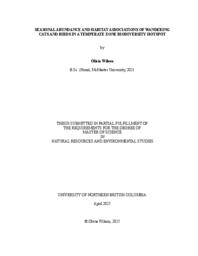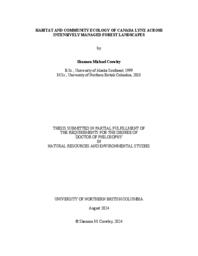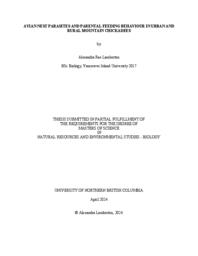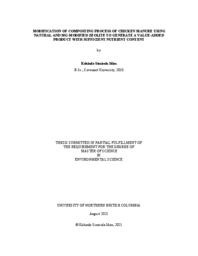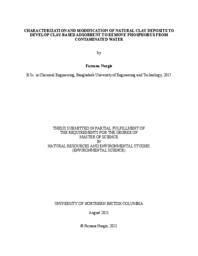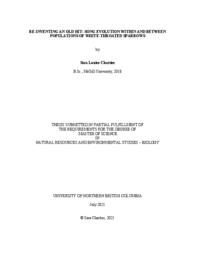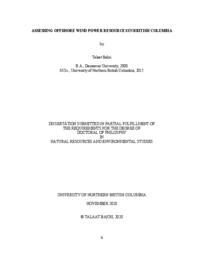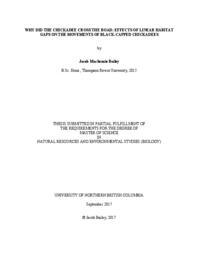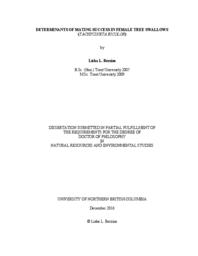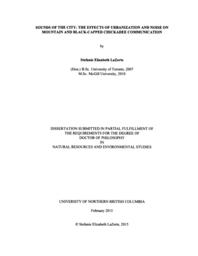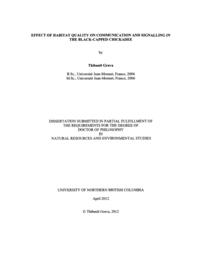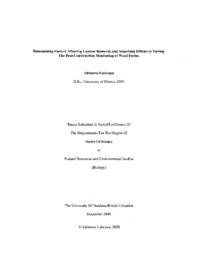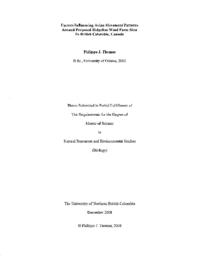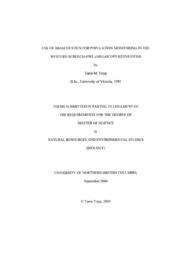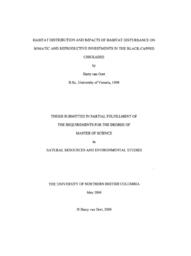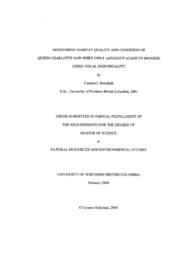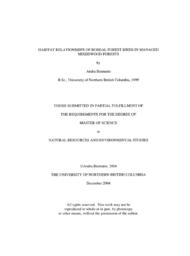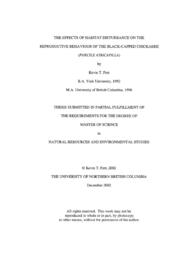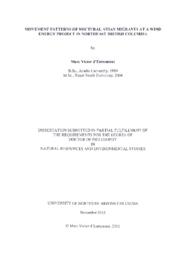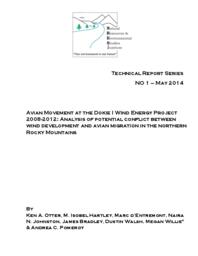Otter, Ken A.
Person Preferred Name
Ken A. Otter
Related Works
Content type
Digital Document
Origin Information
Content type
Digital Document
Origin Information
Content type
Digital Document
Description / Synopsis
Urbanization is considered one of the greatest human-caused threats to biodiversity. Human development and encroachment on native habitats and its impacts on species, however, is nuanced; while it has been found to create detrimental impacts on some species, certain aspects of urbanization may benefit others. This interaction of advantages vs constraints offered by urban landscapes is especially relevant to species that show sufficient behavioural plasticity to settle in this rural/urban interface. The objective of this thesis is to investigate some of these potential costs/benefits of urbanization in mountain chickadees. I first assess a potential positive effect of urban settlement noted in other systems – a decrease in the incidence of nest ecotparasites found in urban landscapes - in mountain chickadees nesting in Kamloops, BC, Canada. I enumerated the blowflies and fleas found in collected nests in 2019 and 2020 to determine whether nest parasitism differs between urban and rural habitats in the region, and whether this in turn influences nest success (Chapter 2). I found that abundance of blow fly puparia was higher in rural nests, but that flea abundance was associated with temperature and not urbanization. Additionally, I observed that urban nests fledged approximately one additional chick per nest. This suggests urban habitats could lift some constraints that would normally decrease nestling condition. I then compared rates of adult chickadees feeding nestlings to determine whether differences in ectoparasitism levels between habitats results in compensatory feeding by parents, and if this affected the growth rate of nestlings (Chapter 3). I did not find evidence that urbanization or ectoparasite abundance influenced parental feeding or growth rate. I did find that feeding rate was lower and that growth rate was higher in warmer years. Other studies showing potential differences in prey availability between habitats, with rural sites having potentially greater abundance of prey, may help explain my results – while prey might be more abundant in one habitat, nestling condition may be less affected by parasite infestation in the other, helping balance the costs/benefits of settlement between habitats. While my results provide some evidence that reduction of parasites in urban areas can benefit urban settling species, further research will be required to determine the mechanism that causes this phenomenon.
Origin Information
Content type
Digital Document
Description / Synopsis
The strategic allocation of resources to maximize fitness is the organizing principle shaping the evolution of life histories. The physiology and behaviour of animals is a manifestation of trade-offs in resource allocation among traits and activities that benefit current or future reproduction. In theory, traits subject to such trade-offs are expected to show negative correlations, but numerous field studies have documented apparent contradictions to theoretical expectations: in some populations, parental effort (allocation to current reproduction) and reproductive performance (i.e., a fitness component) are not negatively correlated to self-maintenance (allocation to future reproduction). One explanation for such findings is that inter-individual variation in resource acquisition can obscure trade-offs by altering the overall quantity of resources individuals are able to invest. Acquisition may influence both the quantity of resources allocated in trade-offs as well as reproductive success. Asymmetries in acquisition may be the product of differences in intrinsic quality (individual phenotypes) and/or environmental factors (territory quality). In a population of breeding mountain bluebirds (Sialia currucoides), I sought to determine how resource acquisition varied, and to identify how it may affect life-history trade-offs and reproductive performance. In my research, I used several lines of inquiry to characterize how resource acquisition varies and affects trade-offs in the study population. First, I showed that offspring quality, a contributor to fitness, is influenced by the types of prey nestling bluebirds are fed by their parents, and that the resources parents provide to their broods vary seasonally and as their nestlings age. Next, I used a short-term manipulation of brood age to find that parents have limited flexibility in their capacity to acquire resources while provisioning broods, which may be due to intrinsic or extrinsic constraints. I then identified relationships among the landscape characteristics of breeding territories (extrinsic factors, potentially influencing acquisition) and the reproductive performance of bluebirds, over an 11-year period. These characteristics, elevation and distance to forest edges, are subsequently linked to differences in microclimate, microhabitat, and parental prey use, providing a partial explanation for why occupancy and reproductive success are spatially clustered and consistent over time. Finally, I used a brood size manipulation to induce changes in parental effort, revealing that acquisition (quantified as both individual and territory quality) influences how mountain bluebirds trade-off one proxy for self-maintenance (energy metabolites) with providing food to their offspring. Interestingly, these effects differed between the sexes. Females generally biased allocation towards current reproduction, increasing provisioning to larger broods, regardless of territory quality; females on low-quality territories subsidized increased provisioning activity by catabolizing stored resources. In contrast, only males on high-quality territories increased parental effort in response to larger broods, and among these individuals, only high-quality males incurred an energy deficit to subsidize this activity. My findings showed that resource acquisition may be critical to understanding why trade-offs differ among individuals, and that both intrinsic and extrinsic limits on acquisition may influence the patterns of allocation we observe in wild populations.
Origin Information
Content type
Digital Document
Description / Synopsis
This research was aimed at developing a composting process of organic waste using natural and modified zeolites by ascertaining how effective they were in retaining phosphorus (P) after 60 days. The experiments included compost (C) containing natural (N) and modified (M) zeolite (Z) treatments (applied at 10% and 15% on a weight basis of the total waste): CNZ10, CNZ15, CMZ10, CMZ15 and C (which is the control treatment with no zeolite addition). The second objective was to compare the barley shoot biomass and nutrient concentration of the various compost treatments mixed with soil and control treatment (just soil) after 45 days of planting in the greenhouse. In general, the benefits of co-addition of compost and zeolite on sandy soil were tested in a completely randomized experimental design. The results indicated that the treatments with the highest zeolite treatments (CNZ15 and CMZ15) proved most effective at retaining P by the end of the composting process (2.8mg and 2.9mg respectively) compared to the lower zeolite ratios and the control treatment; CNZ10 (2.0mg), CMZ10 (1.9mg) and C (0.7mg). The barley shoot biomass results indicated that the treatments that had a combination of soil (S) and modified zeolite (SCMZ10 and SCMZ15) had biomass of 7.67g and 7.24g respectively, followed by the natural zeolite and compost treatments (SCNZ10, SCNZ15 and SC) having 6.19g, 6.38g and 5.99g respectively and were significantly different from the control treatment (S) which had the lowest biomass of 0.48g. With respect to the plant nutrient concentration, N and P were significantly higher in the control treatment (S) compared to the other treatments while K concentration was significantly highest in the compost and some of the zeolite treatments (SC, SCNZ15 and SCMZ15) compared to other treatments. These results were in line with some previous findings where zeolite was used as a soil amendment in agriculture.
Origin Information
Content type
Digital Document
Description / Synopsis
My thesis investigates how urban noise influences the relative audibility of songs to female Mountain Chickadees (Poecile gambeli), who assess male signalling at dawn while roosting within the nest cavity. Over two breeding seasons, I monitored Mountain Chickadees breeding on an urban/rural interface in Kamloops, BC, Canada. I broadcast typical Mountain Chickadee songs, with or without added noise, towards recently unoccupied nests while simultaneously re-recording these songs with microphones outside and inside the nest box to determine the relative audibility in relation to both distance and presence/absence of noise. I then tracked individual males’ behaviour and movement during dawn signalling, while passively recording their songs with microphones — outside and inside the nest box — to determine the relative audibility of signals from the perspective of the roosting female. The relative audibility of songs decreased with increasing distance from the nest, which was compounded by increased urban noise. During dawn signalling, urban males respond to these effects by remaining closer to the nest, resulting in their songs being more audible within the nest than their rural counterparts. Overall, ambient noise and distance had an interactive effect on relative audibility of songs, suggesting complex dynamics of communication networks that may result in a trade-off, where males are forced to prioritize directing their signals to either their social mates or neighbours.
Origin Information
Content type
Digital Document
Description / Synopsis
Modification of natural clays may be a useful approach to produce an effective and low-cost adsorbent to control phosphorous, which is a key factor in controlling the eutrophication of surface waters. In this study, natural clay samples were collected, characterized, modified with ZrCl4, and then their adsorption capacity for removing phosphorus from contaminated water was studied. XRD analysis showed that the natural clay consists of kaolinite, illite, and nontronite as dominant clay mineral phases. The maximum adsorption capacity of the modified clay increased from 0.493 to 11.83 mg P/g compared to the unmodified clay. The adsorption process was fast for both natural and modified samples, achieving more than 80% and 90% phosphorus removal with natural and modified samples, respectively in less than 4 hours. The adsorption data for both clays best fit the Langmuir isotherm, and the rate of phosphorus adsorption was found to follow a pseudo-secondorder kinetic model. The adsorption capacity of both adsorbents decreased with increasing pH, and for the modified clay the change was more significant. Full factorial design and response surface methodology were applied to evaluate and optimize the effects of initial P concentration, contact time, pH, and dose. From the model, the maximum P removal efficiency predicted for the synthetic solution was 91.5% and 99.9% by natural and modified clay, respectively. R2(≈0.98) indicates that the observed results fitted well with the model prediction. Similar to the batch studies, the fixed bed column study showed the developed adsorbents are efficient in removing phosphorus from water in a continuous process as well.
Origin Information
Content type
Digital Document
Description / Synopsis
Cultural evolution of birdsong occurs when songs change over generations and such changes can spread directionally or via drift within and between populations. The objective of this thesis was to document the emergence and spread of a novel song variant, the Modulated-Doublet, within and between populations of White-throated Sparrows. I analysed songs recorded in a Prince George population between 2015-2020 to document song shift within the population. I also analysed songs from public song archives to document song transition on a continental-scale between 2014-2020. I found the Modulated-Doublet started as a rare variant but became the predominant variant within our population over a very short time. At the continental scale, the Modulated-Doublet emerged simultaneously and spread synchronously in multiple breeding populations and migratory routes, replacing the previous variant in those populations. This rapid spread at both scales suggests it is driven by several transmission biases; however further investigation is needed to determine their nature.
Origin Information
Content type
Digital Document
Description / Synopsis
Wind resources are investigated and estimated offshore of the northern and central coasts of British Columbia, Canada. Remote sensing-based wind speed observations from a Synthetic Aperture Radar (SAR) mounted on the Canadian RADARSAT-2 satellite are used for mapping offshore winds. In addition, in-situ wind speed observations extracted from several buoys distributed in the study region are used to analyze the temporal and spatial wind speed variations in relation to wind power generation. Sustained winds above several wind turbine thresholds are analyzed and values of 50-yr and 100-yr return extreme wind speed levels are calculated. The wind variability analysis suggests few interruptions to power generation by either very low wind speeds or extreme wind speed events with high spatial variability between offshore areas and sites located within the coastal mountains. The SAR wind speed fields are characterized by a high spatial resolution but cover a period of less than 2.5 years with a random temporal availability. The SAR fields are extrapolated to reanalysis long-term wind fields that are available over a climatological time period with a sub-daily temporal resolution but a coarse spatial resolution. The extrapolation procedure is developed by applying a statistical downscaling model and a bias-based correction method. Wind fields from both methods are validated against the in-situ observations from buoys. The extrapolated wind fields are used for mapping offshore winds by creating a robust wind climatology that represents the mesoscale wind variance as well as the diurnal wind variability. This wind climatology is used to calculate the wind statistics and power density, in addition to estimate offshore wind resources. Viable areas for wind power development are defined by using high resolution bathymetric data and considering the general environmental and ecological constraints in the region. The estimated offshore wind resource energy using only theiv determined viable areas is found to resemble a large portion of the current total power generation in British Columbia. Most suitable areas for offshore wind farms are determined by developing criteria based on a combination of the turbine tower technology, water depth zoning and power density values.
Origin Information
Content type
Digital Document
Origin Information
Content type
Digital Document
Origin Information
Content type
Digital Document
Origin Information
Content type
Digital Document
Origin Information
Content type
Digital Document
Origin Information
Content type
Digital Document
Origin Information
Content type
Digital Document
Origin Information
Content type
Digital Document
Origin Information
Content type
Digital Document
Origin Information
Content type
Digital Document
Origin Information
Content type
Digital Document
Origin Information
Content type
Digital Document
Origin Information
Content type
Digital Document
Origin Information
Content type
Digital Document
Origin Information
Content type
Digital Document
Origin Information
Content type
Digital Document
Description / Synopsis
"As part of an industry/academic/Canadian Wildlife Service partnership to assess the effects of wind energy development on avian movement patterns and collision risk, we used visual observations and radars to track the avian migrants at the Dokie I Wind Energy Project from 2008 to 2012."--Page 2.
Origin Information

